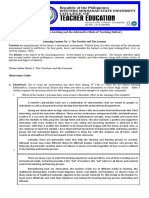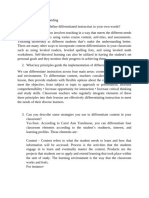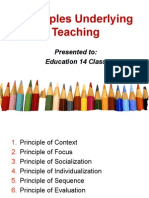Habits of Mind
Habits of Mind
Uploaded by
api-548756435Copyright:
Available Formats
Habits of Mind
Habits of Mind
Uploaded by
api-548756435Original Title
Copyright
Available Formats
Share this document
Did you find this document useful?
Is this content inappropriate?
Copyright:
Available Formats
Habits of Mind
Habits of Mind
Uploaded by
api-548756435Copyright:
Available Formats
TEACHER INSTRUCTIONAL STRATEGIES TO
GRADES K - 12 ENGAGE STUDENTS IN THE COMMON CORE “HABITS OF MIND”
21st century thinkers that are prepared for college and career have identifiable characteristics, “Habits of Mind”, which attribute to their success. These patterns of intellectual behavior can be
taught by intentionally designing environments in which learning, teaching, and assessment all focus on developing students’ “Habits of Mind” capabilities, practices, and metacognition.
This suggested sequence provides teachers a progressive developmental approach toward incorporating new instructional strategies to empower students in the “Habits of Mind”. As strategies are
incorporated and mastered, the “Habits of Mind” are attained, student achievement increases, and student learning in greatly enhanced.
*Please Note: In working with the sequence remember that the strategies are cumulative; each prior strategy supports the next one. This then creates a shift from engagement to empowerment.
COMMON CORE STATE STANDARDS INTENTIONALLY SEQUENCE INSTRUCTIONAL STRATEGIES TO PROGRESSIVELY ENGAGE AND EMPOWER STUDENTS IN THE
“HABITS OF MIND”
“HABITS OF MIND”
Initiating Think, Pair-Share (or, Think, Write-Pair-Share)
English Language Arts Capacities The teacher asks a question or assigns a problem and allows students to think and work with a partner for one to three minutes before requesting
As students advance through the grades and master an answer to the question or problem. In think, pair-share students are given a brief period of time to think independently before working with a
the standards in reading, writing, listening, and partner. While effective in results, this strategy is a significant first step in engaging all students in classroom instructional activities.
language, they should be able to exhibit with Showing Thinking In Classrooms
increasing fullness and regularity the capacities of a The teacher works toward higher degrees of student involvement in classroom activities. Once pair-share is incorporated into classroom routines,
literate individual. the teacher incorporates additional strategies that promote “every pupil response”. Collaboration is used to help as students clarify their own
thinking as part of the “every pupil response” strategy prior to individual share-out. “Every pupil response” strategies include such responses as
1. They demonstrate independence. “thumbs up/thumbs down,” or use of individual white boards for noting answers. Students are also pressed to be more aware of their description.
2. They build strong content knowledge. Students merely provide the steps they used to solve the problem, not their reasoning and thinking about how they knew which processes to use.
3. They respond to the varying demands of In order to reveal student thinking, more challenging, open-ended problems are needed.
audience, task, purpose, and discipline.
Questioning and Wait Time
4. They comprehend as well as critique. As thinking is increased in the classroom, better questioning and wait time are required. Teacher provides thought provoking questions to
5. They value evidence. students, and then allows the students time to think and work toward an answer.
6. They use technology and digital media
strategically and capably. Grouping and Engaging Problems
7. They come to understand other perspectives and The strategy of “grouping and engaging problems” is a significant shift in pedagogy and materials. Students are given challenging
problems/tasks/scenarios to work, and allowed to work on the problem in a group of two, three, or four. Challenging problems/tasks/scenarios
cultures.
take time, effort, reasoning, and thinking to solve.
Mathematical Practices --------------------------------EMPOWERMENT STRATEGIES------------------------------------
For students to succeed, they must increasingly
develop varieties of expertise at all levels in the Using Questions and Prompts with Groups
following ways: Once students are provided with opportunities to solve challenging problems/tasks/scenarios in groups, the teacher increases the level of the
guiding to encourage students to continue persevering to solve the problems/tasks/scenarios. Teacher evokes student curiosity and enthusiasm
1. Make sense of problems and persevere in to continue by providing hints or cues without giving students the answers, and asks probing questions to better assess student thinking and
current understanding.
solving them.
2. Reason abstractly and quantitatively. Allowing Struggle Time
3. Construct viable arguments and critique the Students learn to persevere in solving challenging tasks/scenarios/problems by being allowed to have time to struggle with the challenging
reasoning of others. task/scenario/problem. Students need to understand that real-word, thus authentic school tasks/scenarios/problems do not usually have a quick,
4. Model with mathematics. easy solution. Effective effort is a life-skill and should be learned interdependently and independently. Appropriate degree of difficulty is foremost
5. Use appropriate tools strategically. on teachers’ minds. If the problem is too easy, students do not need to struggle if the problem is far too difficult; students are not capable of
6. Attend to precision. solving the problem. Teachers need to balance working in groups and working independently, and be able to quickly adjust grouping strategies as
the need arises.
7. Look for and make use of structure.
8. Look for and express regularity in repeated Encouraging Reasoning
reasonings. Students need to be encouraged to carefully think about the content area, and to be aware of their own level of knowledge and understanding.
They also need to be able to accurately communicate their thinking to others. Reasoning requires students to pull together patterns, connections,
and understanding about the content, and then apply and adapt their understanding to new learning within and across content areas and real-life
situations.
Adapted from http://www.corestandards.org/the-standards | http://www.mathleadership.com | http://www.cde.ca.gov/sp/el/er/eldstandards.asp ORANGE COUNTY DEPARTMENT OF EDUCATION
You might also like
- DLL CPAR Week 1Document5 pagesDLL CPAR Week 1Rachel Edquid100% (10)
- Ladmmm6 Memos 4Document9 pagesLadmmm6 Memos 4nblaks100% (1)
- Teaching Strats PortfolioDocument21 pagesTeaching Strats Portfolioapi-265908930No ratings yet
- Isbn 978-1-29202-120-1Document445 pagesIsbn 978-1-29202-120-1Jade BambaNo ratings yet
- Teaching Styles of Mathematics Teachers and Their Relationhsip To Students Academic Performance in MathematicsDocument15 pagesTeaching Styles of Mathematics Teachers and Their Relationhsip To Students Academic Performance in Mathematicssir jjNo ratings yet
- Hand OutDocument11 pagesHand OutGlensky Nadz NumbarNo ratings yet
- Lesson 4 Critical Thinking and Problem SolvingDocument5 pagesLesson 4 Critical Thinking and Problem SolvingrohanZorbaNo ratings yet
- 5e Lesson PlanDocument3 pages5e Lesson PlanEric0% (1)
- Instructional Methods and ModelsDocument3 pagesInstructional Methods and Modelsapi-240752628No ratings yet
- UntitledDocument4 pagesUntitledEdel Guyuran VillanuevaNo ratings yet
- BrainstormingDocument11 pagesBrainstormingSuzette MiagaNo ratings yet
- 5e Lesson Plan TemplateDocument3 pages5e Lesson Plan Templatesheri hines100% (1)
- ELE02 Inquiry Based ApproachDocument5 pagesELE02 Inquiry Based ApproachAuditor, Clarence ReyNo ratings yet
- 5e Lesson Plan TemplateDocument4 pages5e Lesson Plan TemplateEric John Carlos Dimasakat100% (1)
- Teacher Self-Assessment of Current Practices in Math ClassDocument2 pagesTeacher Self-Assessment of Current Practices in Math ClassCristina Gabriela BrănoaeaNo ratings yet
- Lesson 12 Supplement TIPS IN FORSTERRING ACTIVE LEARNINGDocument7 pagesLesson 12 Supplement TIPS IN FORSTERRING ACTIVE LEARNINGJenalyn AgcaoiliNo ratings yet
- Education 03abcDocument14 pagesEducation 03abcALMNo ratings yet
- Committed To Excellence in Innovation: Differentiated Assessment ToolDocument8 pagesCommitted To Excellence in Innovation: Differentiated Assessment ToolMhay Anne PerezNo ratings yet
- FS2 Worksheet 1Document4 pagesFS2 Worksheet 1Alwyn U. SacandalNo ratings yet
- What Is ScienceDocument5 pagesWhat Is Scienceliezelconsigna03No ratings yet
- BookletDocument16 pagesBookletAuditor, Clarence ReyNo ratings yet
- Classroom MNGT & Art of QuestioningDocument98 pagesClassroom MNGT & Art of QuestioningMark Anthony B. AquinoNo ratings yet
- Pangasinan State University: School of Advanced Studies Urdaneta City, Pangasinan 2 Semester, Academic Year 2021-2022Document4 pagesPangasinan State University: School of Advanced Studies Urdaneta City, Pangasinan 2 Semester, Academic Year 2021-2022avy mariel alcantaraNo ratings yet
- Psiii Proffesional GoalsDocument6 pagesPsiii Proffesional Goalsapi-451732495No ratings yet
- A Teaching Method That Requires The Students To Present in Concrete Form The Results of Information Gathered About A Concept, Principle or InnovationDocument11 pagesA Teaching Method That Requires The Students To Present in Concrete Form The Results of Information Gathered About A Concept, Principle or InnovationEd Ravfhor Amen AmenNo ratings yet
- Look-Fors in Mathematics: Office of Mathematics Newark Public SchoolsDocument3 pagesLook-Fors in Mathematics: Office of Mathematics Newark Public SchoolsSusana RamirezNo ratings yet
- StrategiesDocument22 pagesStrategiesJericho D. LleraNo ratings yet
- 100 Teaching StrategiesDocument7 pages100 Teaching StrategiesCasandra CalacatNo ratings yet
- Principles of TeachingDocument7 pagesPrinciples of TeachingCrystal RedublaNo ratings yet
- General Method RevisionDocument26 pagesGeneral Method Revisionzakariafarah034No ratings yet
- Activity1 MATH183 ReynonDIDocument4 pagesActivity1 MATH183 ReynonDIms.dannicaiveeNo ratings yet
- 21 Century SUSD CharacteristicsDocument10 pages21 Century SUSD Characteristicscresta2014No ratings yet
- Employing Interactive Classroom Activities in Promoting Fairness andDocument20 pagesEmploying Interactive Classroom Activities in Promoting Fairness andDorothy Diaz MagonciaNo ratings yet
- FS2Document12 pagesFS2Sheejah SilorioNo ratings yet
- Effective Lesson PlanningDocument27 pagesEffective Lesson PlanningAlberto Laborte Jr.No ratings yet
- 8601 Assignment No.2Document18 pages8601 Assignment No.2Muhammad HozaifaNo ratings yet
- Activity in Capter 5Document6 pagesActivity in Capter 5Caitlin AbadNo ratings yet
- Week 6 Principles and StrategiesDocument12 pagesWeek 6 Principles and StrategiesFeliculo JaponaNo ratings yet
- Group 3 Tegr 113Document42 pagesGroup 3 Tegr 113Nicole Kate AsisNo ratings yet
- Techniques of Teaching 2Document12 pagesTechniques of Teaching 2joannNo ratings yet
- Methods and Strategies of TeachingDocument5 pagesMethods and Strategies of TeachingYie Shahana Marie TolosaNo ratings yet
- Definition and Understanding PRITA ASSIGNDocument7 pagesDefinition and Understanding PRITA ASSIGNMAHENDRA KUMAR A/L KANESON MoeNo ratings yet
- Problem SolvingDocument8 pagesProblem SolvingJils SureshNo ratings yet
- Problem Solving Approaches and Analysis ReportsDocument23 pagesProblem Solving Approaches and Analysis Reportskenneth mendozaNo ratings yet
- EXPLICIT INSTRUCTION NTOT Grade 5Document98 pagesEXPLICIT INSTRUCTION NTOT Grade 5LEILANI PELISIGASNo ratings yet
- InstructionalStrategies PedagogicalSkills HOTSDocument36 pagesInstructionalStrategies PedagogicalSkills HOTSApril Ann Pojas FloridaNo ratings yet
- Section 11 - Curriculum DeliveryDocument7 pagesSection 11 - Curriculum DeliveryCathlyn FloresNo ratings yet
- Other Teaching Strategies and Supplementary Methods Math 7 10Document14 pagesOther Teaching Strategies and Supplementary Methods Math 7 10Nelmida, Henriane P.No ratings yet
- Formative Assessment MaterialDocument2 pagesFormative Assessment MaterialJayvelyn EstreraNo ratings yet
- I Hear and I Forget, I See and I Remember and I Do and I UnderstandDocument36 pagesI Hear and I Forget, I See and I Remember and I Do and I UnderstandHazel Grace Tasarra-VargasNo ratings yet
- 20 Simple Assessment Strategies You Can Use Every Day: Strategies To Ask Great QuestionsDocument13 pages20 Simple Assessment Strategies You Can Use Every Day: Strategies To Ask Great Questionsrosmery15No ratings yet
- 12 Teaching Strategies by Jere Brophy PDFDocument2 pages12 Teaching Strategies by Jere Brophy PDFScribdTranslationsNo ratings yet
- Principles and Stategies in Teaching MathDocument35 pagesPrinciples and Stategies in Teaching MathGeraldine RamosNo ratings yet
- EDUC 31 Unit 2 Lesson 4 Learner Centered Principles of Facilitation by Marcelo RaquepoDocument14 pagesEDUC 31 Unit 2 Lesson 4 Learner Centered Principles of Facilitation by Marcelo RaquepoMyrenne Mae BartolomeNo ratings yet
- Unit 2 Final.Document31 pagesUnit 2 Final.Lovely RamosNo ratings yet
- Pedagogy of School Subject PhysicsDocument24 pagesPedagogy of School Subject PhysicsChitra BharghavNo ratings yet
- Instructional PlanningDocument7 pagesInstructional PlanningErica JambonganaNo ratings yet
- Student Directed Learning StrategiesDocument36 pagesStudent Directed Learning Strategiesyhanne100% (17)
- Teaching Strategies-1Document2 pagesTeaching Strategies-1Aicha BoudehaneNo ratings yet
- Educators File Year 2003Document4 pagesEducators File Year 2003sszmaNo ratings yet
- Part III - Approaches in Teaching MathematicsDocument6 pagesPart III - Approaches in Teaching MathematicsCharis VasquezNo ratings yet
- Being a 21st Century Educator: Five Trends You Really Want to KnowFrom EverandBeing a 21st Century Educator: Five Trends You Really Want to KnowRating: 3.5 out of 5 stars3.5/5 (2)
- Physical Chemical Changes Lesson 2 ReflectionDocument2 pagesPhysical Chemical Changes Lesson 2 Reflectionapi-360585476No ratings yet
- 3 Peer ObservationDocument10 pages3 Peer Observationshamma almazroeuiNo ratings yet
- Red Abstract Software Engineer Resume 1Document1 pageRed Abstract Software Engineer Resume 1api-356587857No ratings yet
- Lively Amberlee - Personal Education PhilosophyDocument5 pagesLively Amberlee - Personal Education Philosophyapi-522750560No ratings yet
- Lac Plan For Indigenous Groups SampleDocument2 pagesLac Plan For Indigenous Groups SampleJohnCzyril Deladia DomensNo ratings yet
- Performance Task 2Document1 pagePerformance Task 2Jianne Abriol100% (1)
- ELP 501 - Higher Ed in US - TaylorDocument3 pagesELP 501 - Higher Ed in US - TaylorCj SmithNo ratings yet
- January 10,11Document3 pagesJanuary 10,11Joemar FurigayNo ratings yet
- Principles Underlying TeachingDocument33 pagesPrinciples Underlying Teachingkaizher76% (17)
- Reading Lesson Plan Character AnalysisDocument2 pagesReading Lesson Plan Character Analysisapi-269633108No ratings yet
- Jennifer Helfrich Resume 1Document1 pageJennifer Helfrich Resume 1api-615877534No ratings yet
- Classroom RosterDocument30 pagesClassroom RosterKate HurshNo ratings yet
- John F. Kennedy High School: Principal Assistant PrincipalsDocument1 pageJohn F. Kennedy High School: Principal Assistant Principalsapi-548821965No ratings yet
- Lesson Plan in Problem SolvingDocument9 pagesLesson Plan in Problem SolvingSantoluma GeraldNo ratings yet
- Operations and Algebraic Thinking Order of Operations Background InformationDocument4 pagesOperations and Algebraic Thinking Order of Operations Background Informationapi-291951173No ratings yet
- Facilitating Small Group WorkDocument20 pagesFacilitating Small Group WorkTiffani WilliamsNo ratings yet
- 1st Exam - EDENG 1Document3 pages1st Exam - EDENG 1Joy MagbutongNo ratings yet
- Emily Gallant - Resume 2020Document2 pagesEmily Gallant - Resume 2020api-460522319No ratings yet
- Critical ThinkingDocument7 pagesCritical ThinkingSeshaadhrisTailoringNo ratings yet
- Choice Board Passion ProjectDocument2 pagesChoice Board Passion Projectapi-557236612No ratings yet
- Grade 10 Accomplishment ReportDocument8 pagesGrade 10 Accomplishment ReportBrylee CadigalNo ratings yet
- LaurakrieberresumeDocument2 pagesLaurakrieberresumeapi-404347657No ratings yet
- RPH Laila MaisarahDocument2 pagesRPH Laila MaisarahLaila MaisarahNo ratings yet
- Grade 9 Tos - WW1Document2 pagesGrade 9 Tos - WW1Charina OrtizNo ratings yet
- Clil Lesson Plan 4Document6 pagesClil Lesson Plan 4api-319945675No ratings yet
- Teacher Student InteractionDocument2 pagesTeacher Student InteractionPretty DialloNo ratings yet
- Running Head: Special Education Field Observation 1Document5 pagesRunning Head: Special Education Field Observation 1api-302071047No ratings yet

























































































